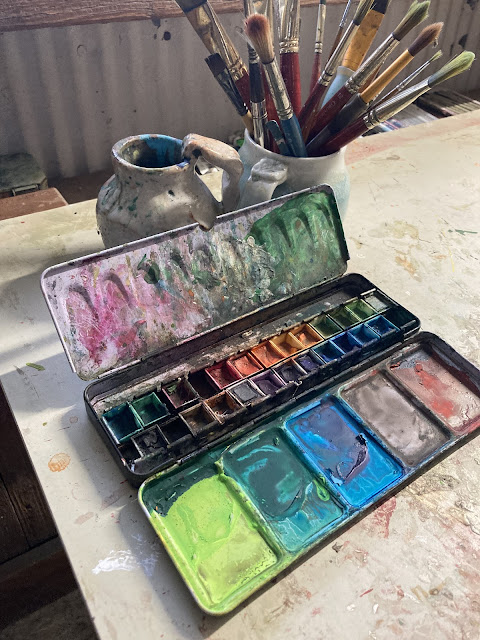Now that my show season is over, it's time for what I lovingly call winter work.
Winter work is studio time. It's when I light the fire in the wood stove and sit down at the drawing table and/or easel, both of which are pulled close to the wood stove. It's winter work because when the weather cools off and the leaves fall, the studio is the most inviting place in my life. The warmth of the fire and the smell of the wood and the blank slate on the easel are what inspire and motivate me to work.
At one of my shows I bought this glorious coffee mug from Paige @rockbottomceramics. It sits on top of the woodstove and keeps the coffee warm for hours. It's a studio staple.
There is purposely a blank canvas on the easel, or in this case, a smooth panel which will eventually be gessoed and painted with an expression of light through leaves. The blank canvas is self care. It's a sign of hope for my future. What will go on that canvas in my future? It's my call, and it's my winter work. So stay tuned. I always pick at least one new thing to learn or do in my winter work, to help my art progress forward. A class, a technique, a new tool. This year the newness started with a workshop in watercolor media, which I recently took at Gaslight Art Colony. It was taught by Carolyn Owen Sommer, who brought all manner of fun art supplies and texture making tools to play and experiment with.
I now feel like a kid at Christmas, what with all the new ideas and materials I learned about in that workshop! So many ways to express the whole concept of light through leaves in my art. Here's a little of what I learned and played with.
Winter work is also a time of personal introspection and inspiration. I promise not to beat myself up too bad about what I could've done better this year, because there's such a huge learning curve. But it does tend to hit differently in the winter when I'm in the studio. Since I'm not out there at shows, getting feedback from customers and fellow artists, the "inside voices" of the internal monologue can tend to get louder. But the winter work is also the time to listen to those voices, consider what they're saying, sift through what is true and has value, and let go of the rest.
What winter work is NOT is open to the public. As much as well-meaning friends and neighbors would like to visit the studio, it is, blissfully, closed to the public. It's not that I'm embarrassed by the mess (I'm not) or concerned for your safety, (again, not) but please understand this is MY private work space. If you really want to see where I work, check out Instagram at parts.of_art. I have been deeply influenced by re-reading the book The Overstory, by Richard Powers. Although a work of fiction, it portrays an entire world existing alongside ours―vast, silent, interconnected, resourceful, inventive, and yet mostly invisible to us. This book has caused me to more deeply appreciate the life of the woods, both above and below ground, and specifically the phenomenon of light filtering through leaves. I look forward to finding more ways to express this concept during my winter work.
Eventually I will post my 2025 show schedule. Stay tuned. I look forward to seeing you at a show next year, where I will be showing the new art that will spring from my winter work.






Comments
Post a Comment